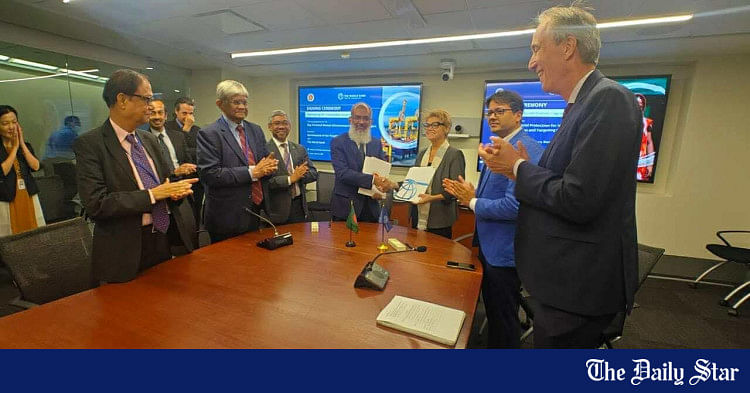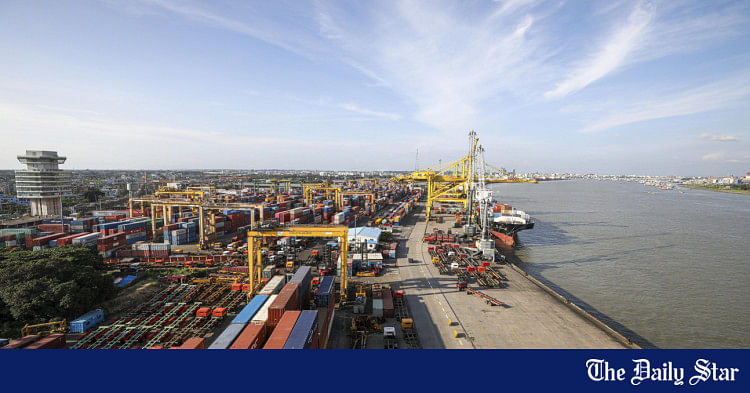Saif
Senior Operative
- 13,247
- 7,269
- Origin

- Axis Group

- Copy to clipboard
- Thread starter
- #105

TK 135.25b Bay Terminal development project in Chattogram approved
The interim government has approved an infrastructure development project worth over Tk 135.25 billion for the Bay Terminal in Chattogram, reviving a long-stalled initiative in a region considered strategically vital both geographically and economically. The Executive Committee of the National Eco
TK 135.25b Bay Terminal development project in Chattogram approved
Published :
Apr 20, 2025 22:53
Updated :
Apr 20, 2025 22:53

The interim government has approved an infrastructure development project worth over Tk 135.25 billion for the Bay Terminal in Chattogram, reviving a long-stalled initiative in a region considered strategically vital both geographically and economically.
The Executive Committee of the National Economic Council (ECNEC) gave the nod on Sunday at a meeting chaired by Chief Adviser Muhammad Yunus at the NEC Conference Room in the Planning Commission complex.
The Bay Terminal Marine Infrastructure Development Project, stuck in bureaucratic limbo for nearly a decade, had seen no visible progress for four and a half months following the fall of the previous administration—even after securing the land needed for construction.
Of the total cost, the World Bank will provide Tk 93.33 billion, while the government will bear the remaining Tk 41.92 billion, reports bdnews24.com.
“This project has been under discussion for years without progress. Today we are finally moving forward with it. The project is the Bay Terminal in Chattogram,” Planning Adviser Wahiduddin Mahmud said after the meeting.
He said while Chattogram is commonly referred to as a seaport, it technically functions as a river port.
“Bangladesh has no real seaport,” he remarked.
“Considering the way our economy is growing, and the scale we expect it to reach over the next 15 to 20 years, this part of the Bay of Bengal is not only important for Bangladesh but also holds regional significance. A maritime port facility here is essential,” he added.
Although the current project has not been categorised as a “mega project”, Wahiduddin said it would eventually be part of a larger initiative involving four terminals—two of which will be developed under public-private partnerships (PPP).
“In total, this will become a mega project,” he said.
“For now, we’re approving a major component of it, but the complete package will be much bigger.”
The adviser said instructions had been issued to begin work without further delay.
Initial work will focus on building a breakwater to shield the port from high waves and storms, along with developing essential support infrastructure.
The breakwater construction and dredging activities will be financed with support from the World Bank.
Wahiduddin hopes that even if the two associated projects take 10 to 15 years to complete, they will be fully operational and capable of meeting the country’s growing trade needs.
“We cannot afford further delay. The Karnaphuli river port was never sufficient, and this has been evident for over 20 years. Large ships cannot even dock there,” he said.
The Bay Terminal Project was first proposed 10 years ago to support the country's future trade expansion and establish an international standard seaport.
Though feasibility studies were conducted three years later, the masterplan was only finalised in November 2023.
Spanning over 6.25 km from behind the Chattogram EPZ near Patenga Sea Beach to Rani Rashmoni Ghat, the terminal has already received most of its required land.
Despite approval of a World Bank loan for the breakwater, no visible progress had been made until now.
Chattogram port has previously faced vessel congestion and long waiting times.
Existing terminals could not accommodate ships with a draft exceeding 10 metres, the depth of the ship's submerged part.
To address these issues and facilitate docking of larger vessels, known as mother vessels, the port authority initiated the Bay Terminal project in 2014, focusing on the Patenga Beach area.
In 2017, a foreign company conducted technical, economic, and environmental studies for the project and developed a master plan, which was finalised and unveiled in November last year.
The plan includes constructing two container terminals measuring 1,225 metres each and a multipurpose terminal 1,500 metres long, for a total of three terminals.
It also proposes 11 jetties across 4.95 kilometres of terminal length, capable of accommodating vessels with 12-metre drafts and 300-metre lengths.
Under the PPP model, agreements have already been signed with two foreign firms for the construction of two terminals.
Although the project is envisioned to span over 352 hectares, the port authority has so far received nearly 230 hectares. These were allocated in May, 2024.
In June, the World Bank approved a $650 million loan for constructing the breakwater and dredging to protect the Bay Terminal from tidal currents.
Sunday’s ECNEC meeting approved 14 projects in total, with a combined estimated cost of Tk 242.47 billion.
Published :
Apr 20, 2025 22:53
Updated :
Apr 20, 2025 22:53
The interim government has approved an infrastructure development project worth over Tk 135.25 billion for the Bay Terminal in Chattogram, reviving a long-stalled initiative in a region considered strategically vital both geographically and economically.
The Executive Committee of the National Economic Council (ECNEC) gave the nod on Sunday at a meeting chaired by Chief Adviser Muhammad Yunus at the NEC Conference Room in the Planning Commission complex.
The Bay Terminal Marine Infrastructure Development Project, stuck in bureaucratic limbo for nearly a decade, had seen no visible progress for four and a half months following the fall of the previous administration—even after securing the land needed for construction.
Of the total cost, the World Bank will provide Tk 93.33 billion, while the government will bear the remaining Tk 41.92 billion, reports bdnews24.com.
“This project has been under discussion for years without progress. Today we are finally moving forward with it. The project is the Bay Terminal in Chattogram,” Planning Adviser Wahiduddin Mahmud said after the meeting.
He said while Chattogram is commonly referred to as a seaport, it technically functions as a river port.
“Bangladesh has no real seaport,” he remarked.
“Considering the way our economy is growing, and the scale we expect it to reach over the next 15 to 20 years, this part of the Bay of Bengal is not only important for Bangladesh but also holds regional significance. A maritime port facility here is essential,” he added.
Although the current project has not been categorised as a “mega project”, Wahiduddin said it would eventually be part of a larger initiative involving four terminals—two of which will be developed under public-private partnerships (PPP).
“In total, this will become a mega project,” he said.
“For now, we’re approving a major component of it, but the complete package will be much bigger.”
The adviser said instructions had been issued to begin work without further delay.
Initial work will focus on building a breakwater to shield the port from high waves and storms, along with developing essential support infrastructure.
The breakwater construction and dredging activities will be financed with support from the World Bank.
Wahiduddin hopes that even if the two associated projects take 10 to 15 years to complete, they will be fully operational and capable of meeting the country’s growing trade needs.
“We cannot afford further delay. The Karnaphuli river port was never sufficient, and this has been evident for over 20 years. Large ships cannot even dock there,” he said.
The Bay Terminal Project was first proposed 10 years ago to support the country's future trade expansion and establish an international standard seaport.
Though feasibility studies were conducted three years later, the masterplan was only finalised in November 2023.
Spanning over 6.25 km from behind the Chattogram EPZ near Patenga Sea Beach to Rani Rashmoni Ghat, the terminal has already received most of its required land.
Despite approval of a World Bank loan for the breakwater, no visible progress had been made until now.
Chattogram port has previously faced vessel congestion and long waiting times.
Existing terminals could not accommodate ships with a draft exceeding 10 metres, the depth of the ship's submerged part.
To address these issues and facilitate docking of larger vessels, known as mother vessels, the port authority initiated the Bay Terminal project in 2014, focusing on the Patenga Beach area.
In 2017, a foreign company conducted technical, economic, and environmental studies for the project and developed a master plan, which was finalised and unveiled in November last year.
The plan includes constructing two container terminals measuring 1,225 metres each and a multipurpose terminal 1,500 metres long, for a total of three terminals.
It also proposes 11 jetties across 4.95 kilometres of terminal length, capable of accommodating vessels with 12-metre drafts and 300-metre lengths.
Under the PPP model, agreements have already been signed with two foreign firms for the construction of two terminals.
Although the project is envisioned to span over 352 hectares, the port authority has so far received nearly 230 hectares. These were allocated in May, 2024.
In June, the World Bank approved a $650 million loan for constructing the breakwater and dredging to protect the Bay Terminal from tidal currents.
Sunday’s ECNEC meeting approved 14 projects in total, with a combined estimated cost of Tk 242.47 billion.




